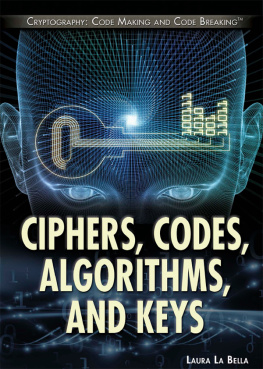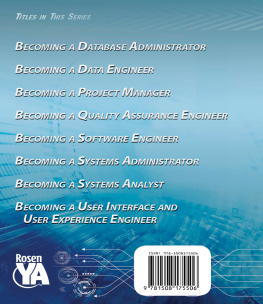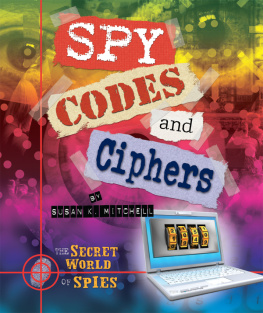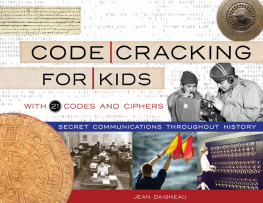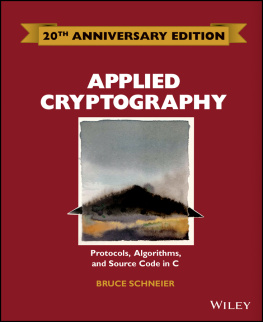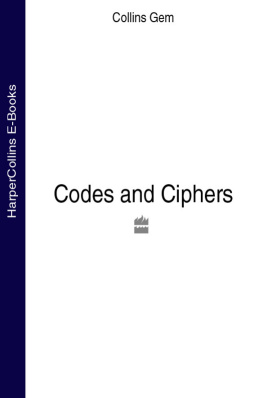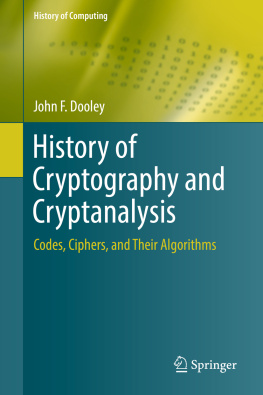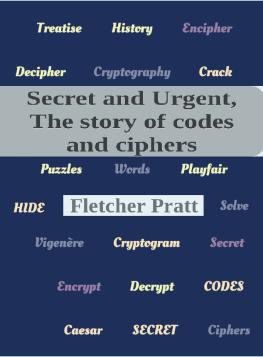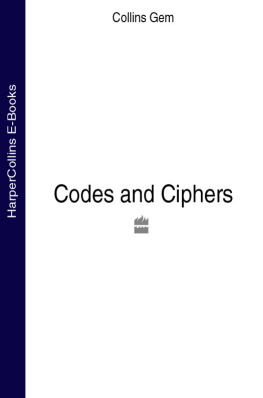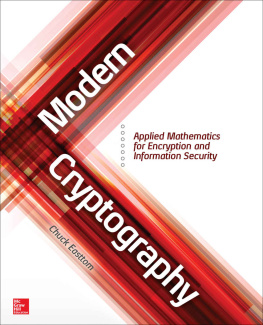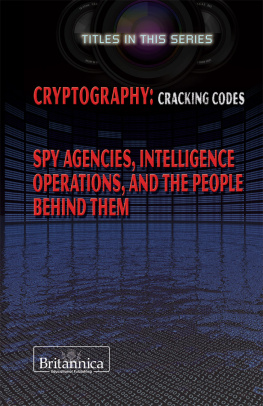Published in 2017 by The Rosen Publishing Group, Inc.
29 East 21st Street, New York, NY 10010
Copyright 2017 by The Rosen Publishing Group, Inc.
First Edition
All rights reserved. No part of this book may be reproduced in any form without permission in writing from the publisher, except by a reviewer.
Library of Congress Cataloging -in -Publication Data
Names: La Bella, Laura, author.
Title: Ciphers, codes, algorithms, and keys / Laura La Bella.
Description: First edition. | New York : Rosen Publishing, 2017. | Series: Cryptography : code making and code breaking | Audience: Grades 712. | Includes bibliographical references and index.
Identifiers: LCCN 2016017414 | ISBN 9781508173069 (library bound)
Subjects: LCSH: CryptographyJuvenile literature. | CiphersJuvenile literature.
Classification: LCC Z103.3 .L25 2017 | DDC 005.8/2dc23
LC record available at https://lccn.loc.gov/2016017414
Manufactured in _________________
I NTRODUCTION
M ore and more of our daily life is digital in some way, from the way we communicate via smartphone, email, and texting to the way we pay for goods and services and access our bank accounts. These highly personal and sensitive pieces of informationour passwords, our bank account numbers, and moreneed to be kept secret. If you want to keep something secret, you have two choices: you can hide the information, or you can make the information unintelligible. Cryptography is the art and science of making information unintelligible and keeping information secure from unintended audiences. Cryptography is what ensures that our sensitive information is kept private.
Cryptography encompasses various ways to encrypt information. Each time you use an automated teller machine (ATM), buy something online, text someone with your smartphone, use a key fob to unlock your car doors, or use your password to access your email, encryption is at work protecting your data. Encryption takes any message and scrambles it in a way that makes it unintelligible.
Cryptography is used by nearly all organizations, both military and private. Our military and diplomatic forces use cryptography to keep confidential information from unauthorized eyes, especially those of foreign and antagonistic governments. Businesses and corporations send and receive sensitive data that has been encoded to try and protect all types of information, from trade secrets to your personal data. Cryptography is used by any organization that uses computers or a computing network to access, store, or communicate information.

Without even realizing it, encryption has become a daily part of our lives. With every password you type, you are using it.
There are a variety of ways to encrypt information. Ciphers, codes, algorithms, and keys all aid in hiding and masking text so that it can be sent safely to its intended audience.
Ciphers are a way to make a message secret by changing or rearranging the letters in a message. They can be simple and done using paper or and pen. Or they can be highly complex and use powerful computing software. Codes are a system of symbols that represent letters, numbers, or words. These are used to mask information and make it difficult for someone to understand your intended message. Algorithms are sequences of processes, or rules, used to encipher and decipher messages. They are complex mathematical equations that are impossible to complete without powerful computing software. Unlocking all of the information hidden by ciphers, codes, and algorithms are keys. A key is a variable that is applied using an algorithm, which is a complex mathematical equation, to a plaintext message to produce encrypted text or to decrypt text. You can think of a key as the secret piece of information that unlocks encrypted information. Without a key, the hidden information, however it has been encrypted, is useless.
Cryptography is the art of keeping information secure, whereas cryptanalysis is the science of breaking encoded data. Many cryptanalysts are highly educated mathematicians. The branch of mathematics encompassing both cryptography and cryptanalysis is called cryptology. This field is exciting and evolving quickly, and it offers exciting career opportunities. Understanding cryptography is the first step to getting a solid foundation in learning how encryption affects our daily lives.
C HAPTER 1
C RYPTOGRAPHY: A S ECRET L ANGUAGE
T he National Security Agency (NSA) has been in charge of encryption systems for the US government since 1952, when the NSA was formed. The foundation of the NSA can trace its roots back to World War I, when codes and ciphers were used by many foreign countries to encrypt secret messages being sent from military leaders to their troops around the world.
Today, the NSA is an intelligence agency that is responsible for monitoring, collecting, and processing information and data on a global scale. They also protect our nations communication and information systems. According to the agencys website, the mission of the NSA is to develop and manage outstanding cryptologic systems and tools, make sense of and secure electronically gathered information, and intensify national security systems and other crucial operations and data as needed.
While the vast majority of the NSAs contributions to the world of cryptography are classified and cannot be shared with the public, one of its most significant contributions to American security came during the Cold War, a long-standing political and military dispute that existed between the United States and the Soviet Union for more than forty years. The Verona Project was a secret program that began in February 1943 when cryptologists began working to break KGB (state security police in the former Soviet Union) encrypted communications being sent from the Soviet Union to the United States. The KGB was the main security agency for the Soviet Union from the mid 1950s until the break up of the Union of Soviet Socialist Republics (USSR) in 1991. The Verona Project cracked encrypted information being sent to and from Soviet spies living in the United States. The project uncovered significant spy rings in the United States, espionage missions, and the identities of many Soviet spies. The Verona Project had hundreds of cryptanalysts working for forty years to decrypt more than three thousand Soviet messages. The Verona Project is a prime example of cryptography at work to ensure our national security.
W HAT I S C RYPTOGRAPHY ?
Cryptography is the science of making information secure by using encryption to transform numbers, words, text, sounds, and images into a stream of unintelligible information.
Encryption surrounds us and makes it possible for us to do many of our day-to-day activities. For every call made on your cell phone, every purchase made in a store or on the internet, and every text message or email you send, an image of the information (cell phone numbers, credit card numbers, text messages, images, and more) is scrambled using encryption.
There are many ways to encrypt information. Some forms are simple while others are extremely complex. Most involve swapping letters for numbers and using mathematic algo- rithms to perform the transformation of comprehendible information into unintelligible data. Regardless of how the information is encrypted, the scrambled informa- tion should give no clues as to how it was encrypted. The how is the secret to maintaining the privacy and confidentiality of the scrambled data. Encryption secures the information and makes it impossible for someone to understand it, unless they hold the key to decrypting it. Decryption is the process of taking the encrypted data and unscrambling it into its original, understandable form.

